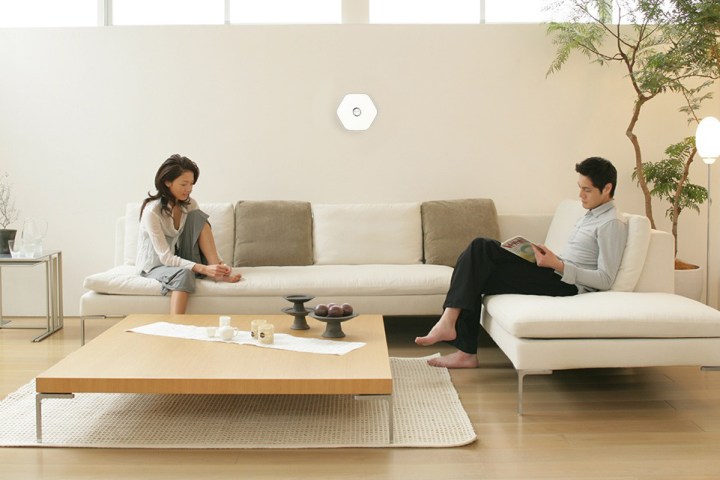
“We don’t ever know who the homeowner is but we know everything about the structure.”
There are countless smart-home hubs homeowners can buy, but Kirio gets installed before you buy your home, while it’s being built. It can control both what builder would put in – air conditioning, lighting, water, and so on, — and the homeowner’s favorite gadgets — Nest thermostats, Alexa speakers, and smart locks, for example. “As long as something has a serial or diagnostic port, we can control it,” said Kirio’s CEO, Rob Green. The benefit is that instead of having your third-party sensor alert you there’s a leak, Kirio gets the message and sends another one out to shut off the water.
The heart of the system is a hub, though Kirio would prefer you don’t really call it that. It’s a white, rounded polygon with a big button in the middle. Inside, there are barometric , humidity, temperature, and vibration sensors, seven radios, a cable connection, and wired connectors for plugging it into a two-gang box. Rougier wants you to put it in your living room. Green thinks most will stick it in the garage. Either way, it will rely on sensors — wired or wireless — located throughout the home for data. Builders can even put sensors behind the walls if they want.

“We don’t ever know who the homeowner is, but we know everything about the structure,” said Green. Using a program called Smart Configure, installers enter the home’s square footage, layout, latitude and longitude, and so on. This means the builders don’t have to do programming themselves, they just get installation instructions. At the same time, Kirio gets the information it needs to effectively manage the house.
Kirio also uses machine learning to get to know the home’s inhabitants. As you move through your day, it gathers data to suggest scenarios. If you arrive home at 6:30, flip on the hallway light, change the setting on the thermostat, and turn on the TV in the kitchen enough times, it can create an “I’m Home” scenario. “Your device is what’s paired up, not you as a person,” said Rougier. “The idea is that as you move forward, you won’t have to use your phone, the home will just react as you move into the room and do things for you.” Smartphone-less kids can use the control panel on the wall. “The idea is to have this be for everybody and not have to an IT person in the house,” said Green.
“The home will just react as you move into the room and do things for you.”
Just as you don’t take your stove with you when you move, the Kirio stays with the house. “We see it as an appliance in the house,” said Rougier. “It’s fixed to the house, not the homeowner. When you leave for good, you hold down the hub’s button for 45 seconds to reset it for the next occupant. Because the device isn’t dependent on your network or the cloud (though it does back up to the cloud), it can still run if your Wi-Fi goes out — though it won’t be able to communicate with devices on your network, like your Echo.
The Kirio has a lithium-ion backup battery in case of power outages as well. If the company suddenly goes out of business, you won’t have a brick on your hands, said Rougier. If a homeowner doesn’t want to use the Kirio, all the systems and devices will still work like those in a non-wired home.
Right now, Kirio is in a dozen homes in the Seattle area, and a builder is including in them in 50 more right now. This is a pilot program, but Green said it’s not a beta product. It’s fully functional, but they want data on how people use their homes before they fully scale in 2018. Kirio is working on a training program to get other companies to do the installing, to make scaling the $1,799 product easier.
Rougier still lives in his passive house, which is now controlled by a Kirio. His kids are healthy, if a little spoiled by their home’s technology. “My family is just used to things coming on by themselves; they go to their grandparents’ and leave all the lights on,” he said. “I think there’s a future where people don’t know what a light switch is anymore.”


